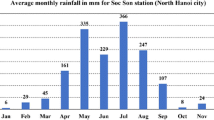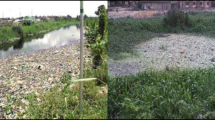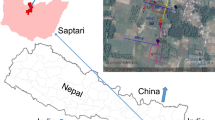Abstract
Investigation of groundwater contamination due to leachate migration in a solid waste disposal site was done using both geophysical and hydrochemical methods. The main goals were to delineate groundwater contamination due to leachate percolation and thus assessment of quality of groundwater from nearby hand-dug wells bordering the dumpsite for drinking purpose. A total of ten resistivity traverses were acquired within and outside the dumpsite using Wenner configuration with constant electrode separation ranging from 5 to 25 m. The 2D resistivity data were processed and inverted using RES2DINV and RES3DINV softwares, respectively. Geochemical assessment of groundwater samples were carried out according to APHA standards while hydrochemical facies of the sampled groundwater was evaluated using Piper Trilinear software. The inverse resistivity models of the subsurface from 2D and 3D imaging revealed low resistivity value less than 10 Ω m suspected to be leachate while 3D inverse sections allowed delineation of leachate, weathered layer, bedrock and seepage path from the dumpsite. The extent of migration was more pronounced in the southern part of the dumpsite, hence possible contamination of shallow groundwater system as dumpsite ages. The results of physico-chemical analyses showed the groundwater samples to be within the limits of WHO/NSDWQ for drinking purpose. However, higher values of concentrations of most analyzed parameters were noticed in well 1 due to its nearness to dumpsite and well 10 due to agricultural activities, respectively. Interpretation of Piper diagram showed CaHCO3 to be dominant facie in the area while alkaline earth metals (\({\text{Ca}}^{2 + } , \;{\text{Mg}}^{2 + }\)) and weak acids (HCO3 −, CO3 −) are dominant cations and anions during both climatic seasons. Groundwater in the study area is of hard, fresh and alkaline in nature.













Similar content being viewed by others
References
Journal article
Abdullahi NK, Osazuwa IB, Sule PO (2011) Application of integrated geophysical techniques in the investigation of groundwater contamination. A case study of municipal solid waste leachate. Ozean J Appl Sci 4(1):7–25
Adepelumi AA, Ako BD, Ajayi TR, Afolabi O, Omotoso EJ (2008) Delineation of Saltwater Intrusion into the freshwater Aquifer of lekki Penni sula, Lagos, Nigeria. Environ Geol 56(5):927–933
Afolayan OS, Ogundele FO, Odewunmi SG (2012) Hydrological implication of solid waste disposal on groundwater quality in urbanized area of Lagos state, Nigeria. Int J Appl Sci Tech 2(5):74–82
Andrea TU, Vagner RE, Giulliana M, Lazaro VZ, Heraldo LG (2012) Case study: a 3D resistivity and Induced polarization imaging from downstream in waste disposal site in Brazil. Environ Earth Sci 66:763–772
Ariyo SO, Enikanoselu EM (2007) Integrated use of geoelectrical Imaging and geochemical analysis in the environmental impact assessment of Egbe dumpsite in Ijebu-Igbo area, southwestern Nigeria. Cont J Earth Sci 1:11–17
Armah FA, Luginaah I, Ason B (2012) Water quality index in the Takwa gold mining area in Ghana. J Transdiscipl Env Stud 11(2):1–15
Assmuth TW, Strandberg T (1993) Groundwater contamination at Finnish landfills. Water Air Soil Pollut 69:163–175
Atekwana EA, Sauck WA, Werkema DD Jr (2000) Investigations of geoelectrical signatures at a hydrocarbon contaminated site. J Appl Geophys 44:167–180
Ayolabi EA, Folorunso AF, Eleyinmi AF, Anuayah EO (2009) Application of 1D and 2D electrical resistivity methods to map aquifers in a complex geologic terrain of foursquare camp, Ajebo, southwestern Nigeria. Pac J Sci Technol 10(2):657–666
Badejo AA, Taiwo AO, Bada BS, Adekunle AA (2013) Groundwater quality assessment around municipal solid waste dumpsite in Abeokuta, southwestern, Nigeria. Pac J Sci Tech 14(1):593–603
Bagarello V, Sgroi A (2007) Using the simplified falling head technique to detect temporal changes in field-saturated hydraulic conductivity at the surface of a sandy loam soil. Soil Tillage Res 94:283–294
Bayowa OG, Olayiwola NS (2015) Electrical resistivity investigation for topsoil thickness, competence and corrosivity evaluation: a case study from Ladoke Akintola University of Technology, Ogbomoso, Nigeria. 2nd international conference on geological and civil engineering. IPCBEE/ACSIT Press, Singapore, 80, pp 52–56
Elueze AA (2000) Compositional appraisal and petrotectonic significance of the Imelu banded ferraginous rock in Ilesha Schist Belt, South western, Nigeria. J Min Geol 36(1):9–18
Fabiyi IP (2008) Depth of hand-dug wells and water chemistry. Example from IBNE Local Government Area, Oyo state, Nigeria. J Soc Sci 17(3):261–266
Fortier R, Allard M, Seguin MK (1994) Effects of physical properties of frozen ground on electrical resistivity logging. Cold Reg Sci Technol 22:361–384
Ikem A, Osibanjo O, Sridliar MKC, Sobande A (2002) Evaluation of groundwater quality characteristics near two waste sites in Ibadan and Lagos, Nigeria. Water Air Solid Pollut 140:307–333
Iyoha AA, Amadasun CVO, Evboumwan IA (2013) 2D Resistivity Imaging investigation of solid waste landfill sites in Ikhyeniro municipacity. Ikpoba Okha Local Government Area, Edo State, Nigeria. J Resour Dev Manag 1:65–69
Jegede SI, Osazuwa IB, Ujuanbi O, Chiemeke CC (2011) 2D electrical imaging survey for situation assessment of leachate plume migration at two waste disposal sites in the Zaria basement complex. Adv Appl Sci Res 2(6):1–8
Johansson S, Rosqvist H, Svensson M, Dahlin T, Leroux V (2011) An alternative methodology for the analysis of electrical resistivity data from a soil gas study. Geophys J Int. doi:10.1111/j.1365-246x.2011.05080.x
Karlik G, Kaya MA (2001) Investigation of groundwater contamination using electric and electromagnetic methods at an open waste-disposal site. A case study from Isparta, Turkey. Environ Geol 40(6):725–731
Kasprzak M (2015) High-resolution electrical resistivity tomography applied to patterned ground, Wedel Jarlsberg land, south–west Spitsbergen. Polar Res 34:25678. doi:10.3402/polar.v34.25678
Kayabali K, Yuksel FA, Yeken T (1998) Integrated use of hydrochemistry and resistivity methods in groundwater contamination caused by a recently closed solid waste site. Environ Geol 36(3–4):227–234
Kneisel C, Hauck C, Fortier R, Moorman B (2008) Advances in geophysical methods for permafrost investigations. Permafrost Periglac Process 19(2):157–178
Kumar D (2012) Efficacy of ERT technique in mapping shallow subsurface anomaly. J Geol Soc India 80:304–307
Lateef TA (2012) Geophysical investigation of groundwater using electrical resistivity method—a case study of Annunciation Grammar School, Ikere lga, Ekiti state, southwestern Nigeria. IOSR J Appl Phys 2(1):01–06
Loke MH, Barker RD (1996) Rapid least squares inversion of apparent resistivity pseudosections by a quasi-Newton method. Geophys Prospect 44:131–152
Matias MS, Marques da Silva M, Ferreira P, Ramalho E (1994) A geophysical and hydrogeological study of aquifers contamination by a landfill. J Appl Geophys 32:155–162
Mazac O, Kelly WE, Landa I (1987) Surface geoelectics for groundwater pollution and protection studies. J Hydrol 93:277–294
Metwaly M, Khalil MA, Al-Sayed ES, El-Kenawy A (2012) Tracing subsurface oil pollution leakage using 2D electrical resistivity tomography. Arab J Geosci. doi:10.1007/S12517-012-0600-z
Mondelli G, Giacheti HL, Howie JA (2010) Interpretation of Resistivity piezocone tests in a contaminated municipal solid waste disposal site. Geotech Test J 33(2):1–14
Munoz-Castelblanco JA, Pereira JM, Delage P, Cui YJ (2011) The influence of changes in water content on the electrical resistivity of a natural unsaturated Loess. Geotech Test J 35(1):1–7
Oladunjoye MA, Olayinka AI, Amidu SA (2011) Geoelectrical imaging at an Abandoned waste dumpsite in Ibadan, southwestern, Nigeria. J Appl Sci 11(22):3755–3764
Paul TI, Debra RR, Marja E, Roger G, Nitin GBH, Sreeram J, Timothy GT, Ramin Y (2007) Review of state of the art methods for measuring water in landfills. Waste Manag 27:729–745
Piper AM (1944) A graphical procedure in the geochemical interpretation of water analysis. Trans Am Geophys Union 25:914–923
Ramakrishnaiah CR, Sadashivaiah C, Ranganna G (2009) Assessment of water quality index for groundwater in Tunikur Taluk, Kamataka state, India. E J Chem 6(2):523–530
Rizwan R, Gurdeep S (2010) Assessment of groundwater quality status by using water quality index method in Orissa, India. World Appl Sci J 9(12):1392–1397
Sasaki Y (1992) Resolution of resistivity tomography inferred from numerical simulation. Geophys Prospect 40:453–464
Scheytt T (1997) Seasonal variations in groundwater chemistry near Lake Belau, Schleswig—Holstein, Northern Germany. Hydrogeol J 5(2):86–95
Soupios P, Papadopoulos I, Kouli M, Georgaki I, Vallianatos F, Kokkinous E (2006) Investigation of waste disposal areas using electrical methods: a case study from Chania, Crete, Greece. Environ Geol. doi:10.1007/S00254-006-0418-7
Tijani MN, Onibalusi SO, Olatunji AS (2002) Hydrochemical and environmental impact assessment of Orita Aperin waste dumpsite, Ibadan, southwestern, Nigeria. Water Resour 13:78–84
Ustra AT, Elis VR, Mondelli G, Zuquette LV, Giacheti HL (2012) Case study: a 3D resistivity and induced polarization imaging from downstream a waste disposal site in Brazil. Environ Earth Sci 66:763–772
Win Z, Hamzah U, Ismail MA, Samsudin AR (2011) Geophysical investigation using resistivity and GPR: a case study of oil spill site at Seberang, Prai, Penang. Bull Geol Soc Malays 57:19–25. doi:10.7186/bgsm001
Yalo N, Lawson M, Adihou C (2014) Geophysical contribution for the mapping of the contaminant plume of leachate from Rubbish Dumpsite of Herie, Benin. Br J Appl Sci Tech 4(1):127–143
Yamasaki MT, Peixoto AS, Lodi PC (2013) Evaluation of electrical resistivity in a tropical sandy soil compacted. Electron J Geotech Eng(EJGE) 19:629–644
Book
Akintola JO (1986) Rainfall distribution in Nigeria, 1892–1983. Impact publishers, Ibadan 380 pp
Dane JH, Hopmans JW (2002) Water retention and storage. In: Dane JH, Topps GC (eds) Methods of soil analysis part 4; physical methods. Soil Science Society of America, Madison, pp 671–690
Gulser C, Candemir F (2008) Prediction of saturated hydraulic conductivity using moisture constants and soil physical properties Samsun 55139
Jones HA, Hockey RD (1964) The geology of southwestern Nigeria. Geological survey of Nigeria Ball 31 89 pp
Kirkham MB (2005) Principles of soil and plant water relations. Elsevier Academic Press, Burlington, pp 145–172
Sawyer GN, McCarthy DL (1967) Chemistry of sanitary engineers, 2nd edn. McGraw Hill, New York 518 p
Yu QH, Cheng GD, Wang WL (2003) The progress of permafrost investigation with geophysical methods in China. In: Permafrost, Phillips, Springman and Arenson (eds), Swets and Zeitlinger, Lisse, ISBN 90 5809 5827. pp 1271–1276
Online document
APHA (2005) Standard methods for the examination of water and waste water, 21st edn. American Public Health Association, Washington
Benson R, Glaccum R, Noel M (1983) Geophysical techniques for sensing buried waste and waste migration. Environ monitor syst lab off Res Develop. Us Environ Protect Ag, Las Vegas, NV, Rep 68-03-3050
CPE (2010) Land recovery and use in Nigeria (Pre-feasibility studies using LFGE). Final report prepared for US Environmental Protection Agency by Centre for People and Environment 57 pp
FAO (2015) IUSS working group WRB 2015. World reference base for soil resources 2014, update, 2015. International soil classification system for naming soils and creating legends for soil maps. World soil resources reports, No 106, FAO Rome 203 pp
Hem JD (1985) Study and interpretation of the chemical characteristics of natural water. USGS water supply paper, vol 2254. pp 117–120
Loke MH (2000) RES2DINV version 3.44 for windows 95/98 and NT: rapid 2D resistivity and IP inversion using the least squares method. Advanced Geosciences Inc., Austin
NSDWQ (2007) Nigerian standard for drinking water quality. Nigeria Industrial Standard, NIS 554. Standard Organization of Nigeria, Lagos 30 pp
WHO (2007) Water for pharmaceutical use in quality assurance of pharmaceuticals A compendium of Guidelines and Related materials, 2nd edn. World Health Organization, Geneva, pp 170–187
Author information
Authors and Affiliations
Corresponding author
Rights and permissions
About this article
Cite this article
Ganiyu, S.A., Badmus, B.S., Oladunjoye, M.A. et al. Assessment of groundwater contamination around active dumpsite in Ibadan southwestern Nigeria using integrated electrical resistivity and hydrochemical methods. Environ Earth Sci 75, 643 (2016). https://doi.org/10.1007/s12665-016-5463-2
Received:
Accepted:
Published:
DOI: https://doi.org/10.1007/s12665-016-5463-2




